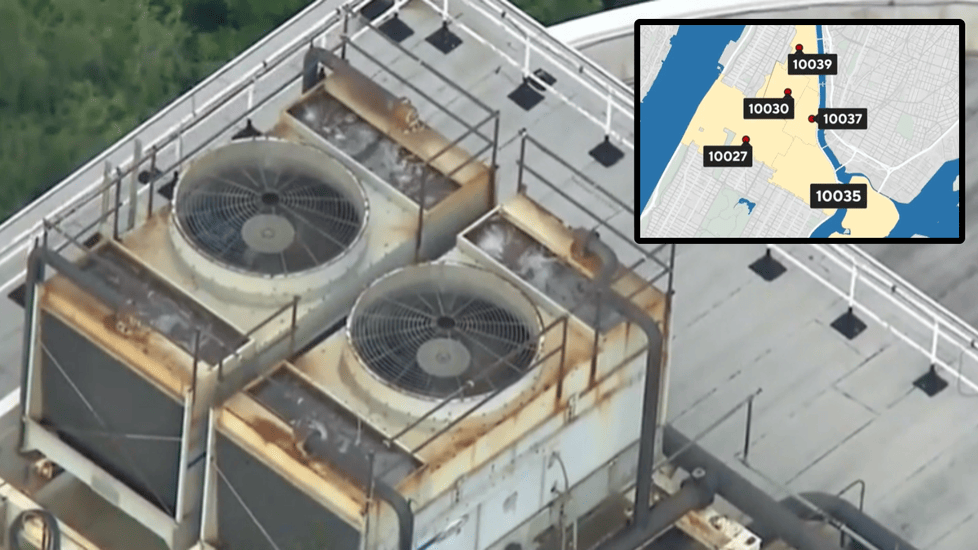6 Dead, Over 100 Sickened as Legionnaires’ Cases Rise in Harlem

- Six deaths, 112 confirmed cases in Harlem-based Legionnaires’ outbreak
- 12 contaminated cooling towers identified — four on city-owned buildings
- Lawsuit filed by Rev. Al Sharpton and Ben Crump
- Outbreak spans five ZIP codes in central Harlem
- City’s largest outbreak since 2015

A sixth person has died in Harlem’s ongoing Legionnaires’ disease outbreak, marking New York City's largest outbreak of the illness in nearly a decade, city health officials confirmed Thursday.
Since late July, 112 people have been infected, with seven still hospitalized across five Harlem ZIP codes: 10027, 10030, 10035, 10037, and 10039.
The identities of those who died have not been made public.
Bacteria Linked to 12 Cooling Towers
City investigators have linked the outbreak to 12 cooling towers in northern Manhattan, including four atop city-owned buildings like Harlem Hospital.
These towers were:
-
Contaminated with Legionella bacteria
-
Drained and disinfected after testing positive
-
Located across properties with large-scale cooling systems that release mist into the air
Cooling towers are used to regulate temperature in large buildings by spraying water into the air. When not properly cleaned or maintained, they can harbor bacteria that spreads through aerosolized droplets — not through drinking water or person-to-person contact.
New Cases Slowing, But Risk Remains
New infections have continued to decline since August 5, according to city health data, suggesting the outbreak is being brought under control.
Acting Health Commissioner Dr. Michelle Morse said in a statement on Tuesday, “remediation efforts have been effective as new cases continue to decrease.”
Image: NYC Health Department
Lawsuit Alleges Negligence in Harlem Hospital Cooling Tower
On Wednesday, Rev. Al Sharpton and civil rights attorney Ben Crump filed a lawsuit against a construction company that worked on Harlem Hospital and other nearby sites. Sharpton suggested the city dropped the ball on inspections.
They allege:
-
Rainstorms in July left standing water in cooling towers
-
Towers were not properly treated, allowing bacteria to grow
-
City inspections failed to catch the risks in time
NYC’s Largest Outbreak Since 2015
This is New York’s most serious Legionnaires’ outbreak since 2015, when:
-
138 people were infected, and
-
16 people died in the South Bronx — just across the Harlem River
More recently, a 2022 outbreak in the Bronx’s Highbridge neighborhood sickened 30 people.
The current Harlem outbreak stands out not only by size, but because of its concentration in a historically Black and lower-income area, where health inequities are a known concern.
Community Meeting Draws Concerned Harlem Residents
Harlem residents gathered Thursday evening for an information session hosted by District 9 City Council Member Yusef Salaam, aimed at addressing community concerns about the Legionnaires’ outbreak.
Attendees took notes and asked detailed questions as health officials explained how Legionnaires’ disease spreads, how it's treated, and what residents should watch for.
Council Member Salaam emphasized the importance of community empowerment during public health crises.
“We also wanna make sure that we also know how to advocate for ourselves. That's what this is really about,” he said.
Among those attending was Denise Merchant, who had just left Harlem Hospital, where her sister has been recovering from Legionnaires’ since August 2. Merchant said her sister is improving but remains too weak to walk far and will soon be transferred to a rehab facility.
“The fever is no longer there, the pneumonia is no longer there, the sepsis is no longer there, but the delirium is still there,” she said. “She does have underlying issues, and I think that’s one of the reasons it hit her the way it did.”
Another resident from one of the affected ZIP codes shared that she experienced symptoms like chills and cold feet but was never tested for Legionnaires’ disease.
Out of caution, she said she covered all the vents in her apartment, but a representative from the Department of Health clarified that because Legionella bacteria are airborne, the risk isn’t isolated to any one building. People can be exposed both indoors and outdoors if contaminated mist is present in the environment.
What to Know About Legionnaires’ Disease
Legionnaires’ disease is a severe form of pneumonia caused by breathing in small droplets of water that contain Legionella bacteria. It's not contagious and does not spread through drinking water.
Risk factors:
-
Age 50 and older
-
Smokers or those with chronic lung disease
-
Weakened immune systems due to illness or medications
Symptoms:
-
High fever (often over 104°F)
-
Cough (may bring up mucus or blood)
-
Muscle aches
-
Chills
-
Confusion or mental changes
-
Shortness of breath
-
Headache
-
Fatigue
-
Nausea, vomiting, or diarrhea
-
Chest pain
Symptoms can appear 2–10 days after exposure, and sometimes up to 2 weeks.
Though most healthy people exposed do not get sick, the CDC says about 1 in 10 who develop the illness die due to complications.
Possible complications include lung failure and death. Legionnaires’ is treatable with antibiotics, but delays in treatment can lead to severe outcomes.
A Preventable Disease
According to the CDC, 90% of Legionnaires’ outbreaks are preventable with effective water management.
Legionella bacteria are naturally found in freshwater, but grow rapidly in warm, stagnant water — especially in:
-
Cooling towers
-
Hot tubs
-
Hot water tanks
-
Large plumbing systems
In New York, Legionnaires’ outbreaks have historically occurred more often in predominantly lower-income Black and Latino neighborhoods, where older infrastructure and limited maintenance resources may increase vulnerability to bacterial spread.
Climate Change Increasing Risk
Warmer temperatures and higher humidity — both worsened by climate change — are creating ideal conditions for Legionella growth in urban areas like New York.
Experts warn that outbreaks may become more frequent in the years ahead, especially in cities with aging infrastructure and vulnerable populations.

What Residents Should Do
The NYC Health Department advises anyone in the affected Harlem ZIP codes who experiences flu-like symptoms to seek medical attention immediately — particularly those in high-risk groups.
For the latest updates and safety alerts, visit the NYC DOHMH Legionnaires' page.
Separate Bronx Cases Under Investigation
Health officials are also investigating at least two cases of Legionnaires’ disease at a condominium complex in the Bronx.
Authorities say these patients are not connected to the Harlem cluster, which has infected 111 people and killed six since late July.
The Bronx cases are believed to be linked to the building’s internal hot water plumbing system, which differs from outbreaks tied to cooling towers like the one in Harlem.
Outbreaks involving plumbing are typically self-contained within a single building, while those connected to cooling towers can affect entire neighborhoods or zip codes, depending on how far contaminated mist travels.
🤔Nurses, share your thoughts in the discussion forum below!
If you have a nursing news story that deserves to be heard, we want to amplify it to our massive community of millions of nurses! Get your story in front of Nurse.org Editors now - click here to fill out our quick submission form today!





